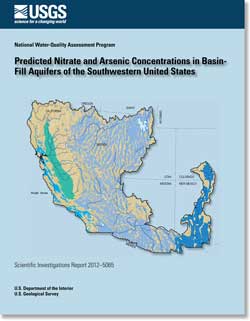 Summary
Summary
The National Water-Quality Assessment (NAWQA) Program of the U.S. Geological Survey (USGS) is conducting a regional analysis of water quality in the principal aquifer systems across the United States. The Southwest Principal Aquifers (SWPA) study is building a better understanding of the susceptibility and vulnerability of basin-fill aquifers in the region to groundwater contamination by synthesizing baseline knowledge of groundwater-quality conditions in 16 basins previously studied by the NAWQA Program. The improved understanding of aquifer susceptibility and vulnerability to contamination is assisting in the development of tools that water managers can use to assess and protect the quality of groundwater resources.
Human-health concerns and economic considerations associated with meeting drinking-water standards motivated a study of the vulnerability of basin-fill aquifers to nitrate contamination and arsenic enrichment in the southwestern United States. Statistical models were developed by using the random forest classifier algorithm to predict concentrations of nitrate and arsenic across a model grid that represents about 190,600 square miles of basin-fill aquifers in parts of Arizona, California, Colorado, Nevada, New Mexico, and Utah. The statistical models, referred to as classifiers, reflect natural and human-related factors that affect aquifer vulnerability to contamination and relate nitrate and arsenic concentrations to explanatory variables representing local- and basin-scale measures of source, aquifer susceptibility, and geochemical conditions. The classifiers were unbiased and fit the observed data well, and misclassifications were primarily due to statistical sampling error in the training datasets.
The classifiers were designed to predict concentrations to be in one of six classes for nitrate, and one of seven classes for arsenic. Each classification scheme allowed for identification of areas with concentrations that were equal to or exceeding the U.S. Environmental Protection Agency drinking-water standard. Whereas 2.4 percent of the area underlain by basin-fill aquifers in the study area was predicted to equal or exceed this standard for nitrate (10 milligrams per liter as N; mg/L), 42.7 percent was predicted to equal or exceed the standard for arsenic (10 micrograms per liter; μg/L). Areas predicted to equal or exceed the drinking-water standard for nitrate include basins in central Arizona near Phoenix; the San Joaquin, Inland, and San Jacinto basins of California; and the San Luis Valley of Colorado. Much of the area predicted to equal or exceed the drinking-water standard for arsenic is within a belt of basins along the western portion of the Basin and Range Physiographic Province in Nevada, California, and Arizona. Predicted nitrate and arsenic concentrations are substantially lower than the drinking-water standards in much of the study area—about 93.0 percent of the area underlain by basin-fill aquifers was less than one-half the standard for nitrate (5.0 mg/L), and 50.2 percent was less than one-half the standard for arsenic (5.0 μg/L).
|
First posted September 6, 2012
Part or all of this report is presented in Portable Document Format (PDF); the latest version of Adobe Reader or similar software is required to view it. Download the latest version of Adobe Reader, free of charge. |